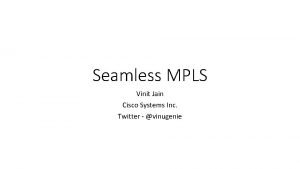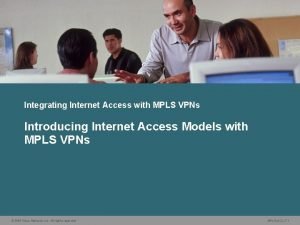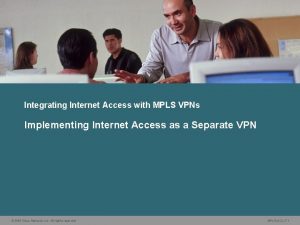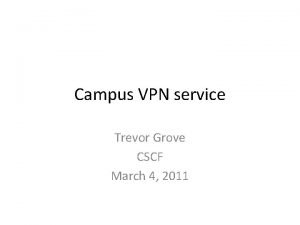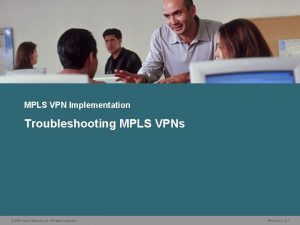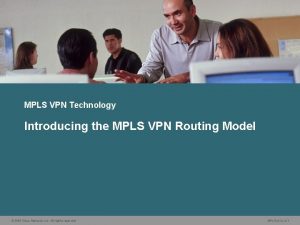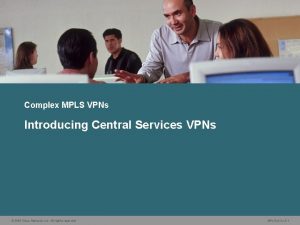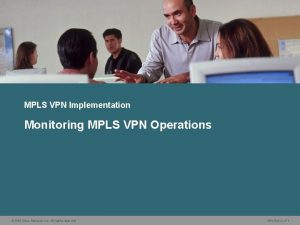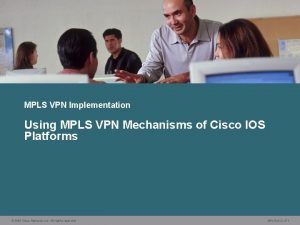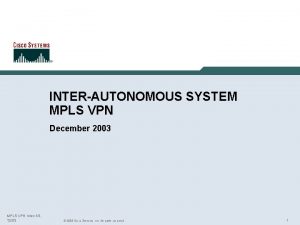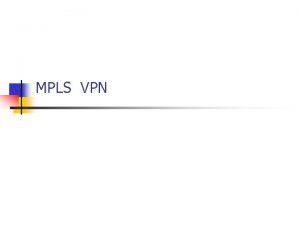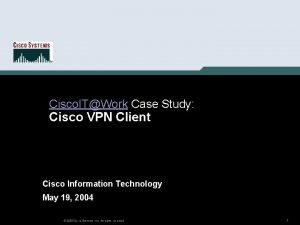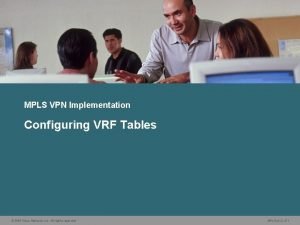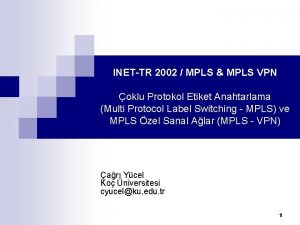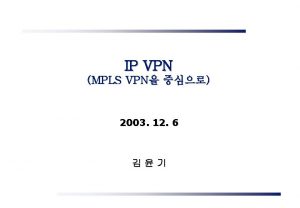MPLS VPN Technology Introducing VPNs 2006 Cisco Systems




















- Slides: 20

MPLS VPN Technology Introducing VPNs © 2006 Cisco Systems, Inc. All rights reserved. MPLS v 2. 2— 4 -1

Outline • Overview • Traditional Router-Based Network Connectivity • Advantages of VPNs • VPN Terminology • What Are the VPN Implementation Models? • What Are Overlay VPN Technologies? • What Are Peer-to-Peer VPN Technologies? • What Are the Benefits of VPNs? • What Are the Drawbacks of VPNs? • Summary © 2006 Cisco Systems, Inc. All rights reserved. MPLS v 2. 2— 4 -2

Traditional Router-Based Networks Traditional router-based networks connect customer sites through routers connected via dedicated point-to-point links. © 2006 Cisco Systems, Inc. All rights reserved. MPLS v 2. 2— 4 -3

Virtual Private Networks • VPNs replace dedicated point-to-point links with emulated point-to-point links sharing common infrastructure. • Customers use VPNs primarily to reduce their operational costs. © 2006 Cisco Systems, Inc. All rights reserved. MPLS v 2. 2— 4 -4

VPN Terminology © 2006 Cisco Systems, Inc. All rights reserved. MPLS v 2. 2— 4 -5

VPN Terminology (Cont. ) © 2006 Cisco Systems, Inc. All rights reserved. MPLS v 2. 2— 4 -6

VPN Implementation Models VPN services can be offered based on two major models: • Overlay VPNs, in which the service provider provides virtual point-to-point links between customer sites • Peer-to-peer VPNs, in which the service provider participates in the customer routing © 2006 Cisco Systems, Inc. All rights reserved. MPLS v 2. 2— 4 -7

Overlay VPNs: Hub-and-Spoke Topology © 2006 Cisco Systems, Inc. All rights reserved. MPLS v 2. 2— 4 -8

Overlay VPNs: Redundant Hub-and-Spoke Topology © 2006 Cisco Systems, Inc. All rights reserved. MPLS v 2. 2— 4 -9

Overlay VPNs: Layer 2 Implementation This is the traditional switched WAN solution: • The service provider establishes Layer 2 virtual circuits between customer sites. • The customer is responsible for all higher layers. © 2006 Cisco Systems, Inc. All rights reserved. MPLS v 2. 2— 4 -10

Overlay VPNs: IP Tunneling VPN is implemented with IP-over-IP tunnels: • Tunnels are established with GRE or IPsec. • GRE is simpler (and quicker); IPsec provides authentication and security. © 2006 Cisco Systems, Inc. All rights reserved. MPLS v 2. 2— 4 -11

Overlay VPNs: Layer 2 Forwarding • VPN is implemented with PPP-over-IP tunnels. • VPN is usually used in access environments (dialup, digital subscriber line). © 2006 Cisco Systems, Inc. All rights reserved. MPLS v 2. 2— 4 -12

Overlay VPNs: Layer 3 Routing • The service provider infrastructure appears as point-to-point links to customer routes. • Routing protocols run directly between customer routers. • The service provider does not see customer routes and is responsible only for providing point-to-point transport of customer data. © 2006 Cisco Systems, Inc. All rights reserved. MPLS v 2. 2— 4 -13

Peer-to-Peer VPNs: Implementation Techniques © 2006 Cisco Systems, Inc. All rights reserved. MPLS v 2. 2— 4 -14

Peer-to-Peer VPNs: Packet Filters © 2006 Cisco Systems, Inc. All rights reserved. MPLS v 2. 2— 4 -15

Peer-to-Peer VPNs: Controlled Route Distribution © 2006 Cisco Systems, Inc. All rights reserved. MPLS v 2. 2— 4 -16

Benefits of VPN Implementations • Overlay VPN: – Well-known and easy to implement – Service provider does not participate in customer routing – Customer network and service provider network are well-isolated • Peer-to-peer VPN: – Guarantees optimum routing between customer sites – Easier to provision an additional VPN – Only sites provisioned, not links between them © 2006 Cisco Systems, Inc. All rights reserved. MPLS v 2. 2— 4 -17

Drawbacks of VPN Implementations • Overlay VPN: – Implementing optimum routing requires a full mesh of virtual circuits. – Virtual circuits have to be provisioned manually. – Bandwidth must be provisioned on a site-to-site basis. – Overlay VPNs always incur encapsulation overhead. • Peer-to-peer VPN: – The service provider participates in customer routing. – The service provider becomes responsible for customer convergence. – PE routers carry all routes from all customers. – The service provider needs detailed IP routing knowledge. © 2006 Cisco Systems, Inc. All rights reserved. MPLS v 2. 2— 4 -18

Summary • Traditional router-based networks connect via dedicated point-to -point links. • VPNs use emulated point-to-point links sharing a common infrastructure. • The two major VPN models are overlay VPN and peer-to-peer VPN. – Overlay VPNs use well-known technologies and are easy to implement. – Overlay VPN virtual circuits must be provisioned manually. – Peer-to-peer VPNs guarantee optimum routing between customer sites. – Peer-to-peer VPNs require that the service provider participate in customer routing. © 2006 Cisco Systems, Inc. All rights reserved. MPLS v 2. 2— 4 -19

© 2006 Cisco Systems, Inc. All rights reserved. MPLS v 2. 2— 4 -20
 Mpls architecture
Mpls architecture Vodafone machinelink
Vodafone machinelink Mpls vpn architecture
Mpls vpn architecture Mpls internet access
Mpls internet access Mpls internet access
Mpls internet access Cisco mpls certification
Cisco mpls certification Vpnsa
Vpnsa Ipsec vpn vs ssl vpn
Ipsec vpn vs ssl vpn Vpn uwaterloo
Vpn uwaterloo Anyconnect per app vpn
Anyconnect per app vpn Uf vpn client
Uf vpn client Mobility express mesh
Mobility express mesh Signal phrase for quotes
Signal phrase for quotes A concise introduction to linguistics
A concise introduction to linguistics Introducing james joyce
Introducing james joyce Body paragraph starters
Body paragraph starters Counterclaim in writing
Counterclaim in writing Introduce yourself sample
Introduce yourself sample Warm up introducing yourself
Warm up introducing yourself Introducing family members in french
Introducing family members in french Poetic device
Poetic device
